Tourism in the EU - what a normal summer season looks like - before Covid-19
Data extracted in May 2020.
Highlights
In summer 2019, nearly one third (32 %) of annual nights spent at tourist accommodation establishments were recorded in July and August.
The share of July and August in total nights spent at tourist accommodation in 2019 ranges from 23 % in Malta to 58 % in Croatia.
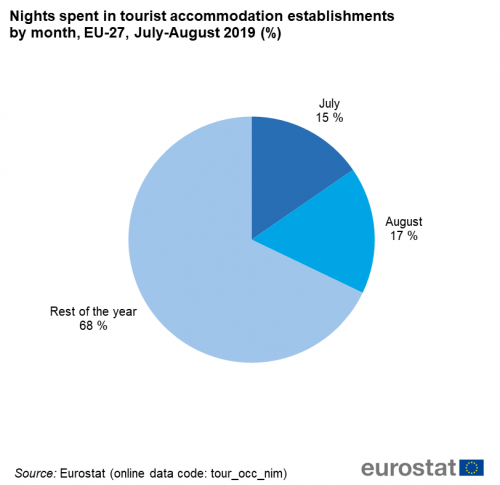
Source: Eurostat (tour_occ_nim)
Tourism occupies an important place in the economy of the Member States, with tourism activities representing a large potential source of employment. Tourism satellite accounts show that the annual tourism gross value added in the EU is estimated at EUR 787 billion.
Since the beginning of the Covid-19 pandemic, virtually all Member States have implemented containment measures and restrictions on non-essential travel, closed their borders and reinstated internal border controls within the Schengen area, often accompanied by requirements for cross-border travellers to stay in quarantine. This meant that millions of European citizens were suddenly unable to travel. In the course of March 2020, tourism came to a grinding halt and it is not likely that the recovery will start before the summer peak season.
The European Commission released on 13 May 2020 its Communication “Tourism and transport in 2020 and beyond”. This article provides some background information that could be used to quantify the potential impact of the Covid-19 crisis on the tourism economy in the summer peak season in 2020.
For the purpose of this article, the summer peak is defined as the months July and August (not including June, but focusing on the two summer months overlapping with the main holiday season in most Member States). Note that a similar background article is available on “what a normal spring season looks like” (spring season defined as the the period spanning the months March to June included).
Full article
One third of the annual nights spent at EU tourist accommodation
The main holiday season during July and August records nearly one third (32 %) of annual nights spent at tourist accommodation establishments (2019 data) (see Figure 1). These two months represent 915 million nights spent, out of an annual total of 2.8 billion nights spent at accommodation establishments across the EU. August tends to be slightly more dominant (17 % of the annual total) than July (15 %).

Source: Eurostat (tour_occ_nim)
The weight of the summer season in annual accommodation figures is very significant in all Member States, but varies strongly across the European Union, ranging from 23 % in Malta to 42 % in Greece, 46 % in Bulgaria and 58 % in Croatia (see Table 1 and Figure 2). The share of the summer months in annual tourism is similar when looking at nights spent by residents and nights spent by non-residents, with residents slightly favouring August over July.
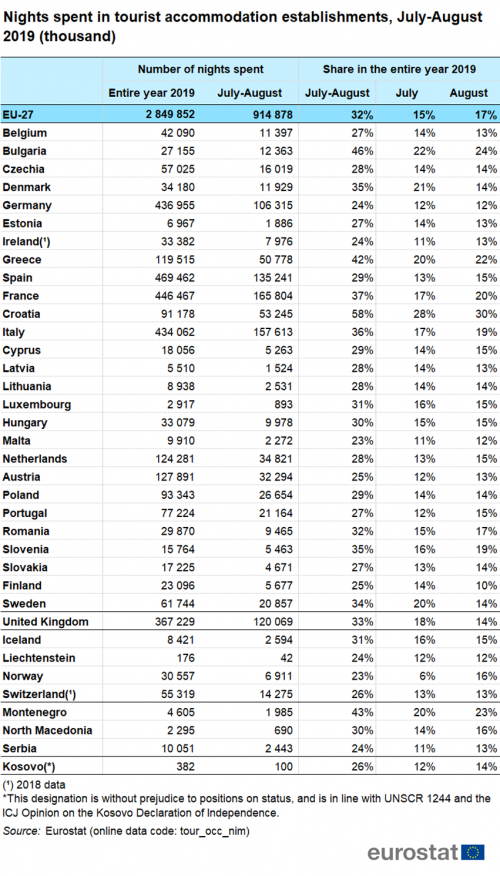
Source: Eurostat (tour_occ_nim)
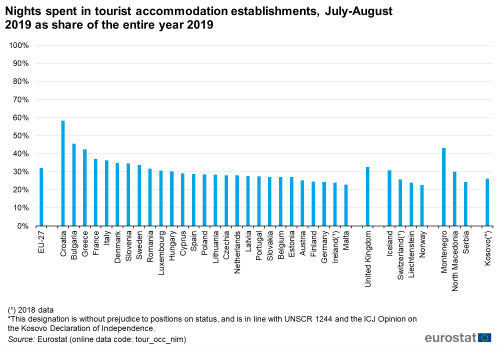
Source: Eurostat (tour_occ_nim)
More than 1.9 billion tourism nights and EUR 138 billion spent
The first part of this article looked at summer season occupancy of EU tourist accommodation establishments in 2019. The remaining part looks at trips made by EU residents in July and August 2018 (data for 2019 not yet available). In July and August, residents of the EU made over 270 million trips, corresponding to 24 % of the total number of tourism trips with overnight stays made in a year (2018 data) (see Table 2). Trips during the summer peak are significantly longer (7.1 nights on average, compared to 4.6 nights during the spring season) and account for more than 1.9 billion overnight stays. These trips and nights represent EUR 138 billion spending, of which EUR 61 billion was spent on domestic trips and EUR 49 billion on trips to destinations in other EU Member States (and the remaining EUR 28 billion on trips to non-EU destinations).

Source: Eurostat (tour_dem_ttmd) (tour_dem_tnmd)
The pattern of destinations preference in summer does not differ much from the destination visited during the entire year: 7 out of 10 trips were domestic trips.
The highest number of tourism trips in the summer months July and August are made by residents of France (53 million trips, of which 40 million domestic trips), Germany (48 million trips, of which 25 million domestic trips) and Spain (39 million trips, of which 34 million domestic trips) (see Tables 3a, 3b and 3c for detailed data by country).

Source: Eurostat (tour_dem_ttmd)
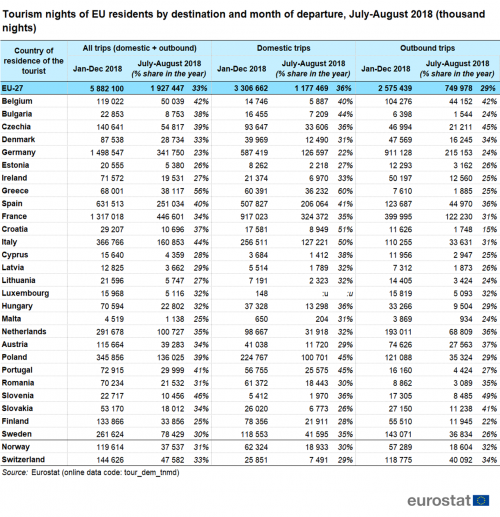
Source: Eurostat (tour_dem_tnmd)
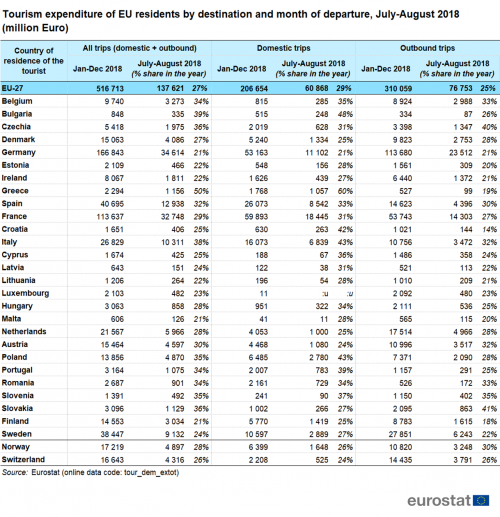
Source: Eurostat (tour_dem_extot)
Europeans spend more than 500 million overnights in the EU
The previous chapter looked at the data from the point of view of the country of origin of the visitor and the destination of the trip (domestic trips within the country of residence, and outbound trips to foreign countries). This chapter focuses on intra-EU tourism trips by looking at the internal tourism of each EU country (domestic trips made by its own residents, and inbound trips of tourists coming from other EU countries) (see Tables 4a, 4b and 4c). During the summer peak (July and August), EU residents made more than 250 million tourism trips to destinations in the EU, corresponding to 1.7 billion nights in rented or non-rented accommodation (of which 1.2 billion nights in their own country and 500 million nights in other EU Member States). During these summer trips, they spent nearly EUR 110 billion, or close to EUR 1.8 billion per day during the two summer months. Looking at inbound overnight trips from other EU countries, regardless of the type of accommodation, in two countries July and August account for more than half of the annual intra-EU visitors: Bulgaria (53 %) and Croatia (54 %). When looking at domestic tourism, Greece records important domestic flows in summer (60 % of the annual number of trips made by residents of Greece to destinations within the country).
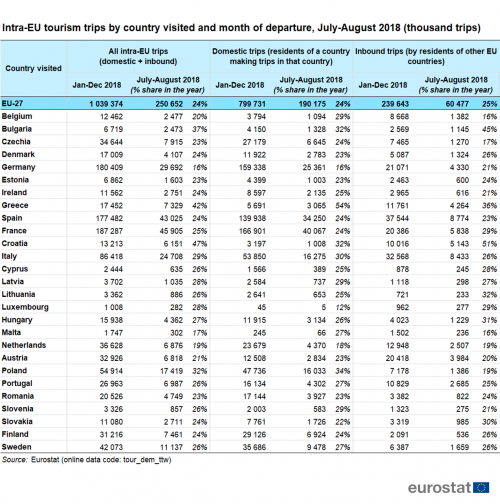
Source: Eurostat (tour_dem_ttw)

Source: Eurostat (tour_dem_tnw)

Source: Eurostat (tour_dem_extotw)
Source data for tables and graphs
Data sources
Tourism, in a statistical context, refers to the activity of visitors taking a trip to a destination outside their usual environment, for less than a year. It can be for any main purpose, including business, leisure or other personal reasons other than to be employed by a resident person, household or enterprise in the place visited.
In July 2011, the European Parliament and the Council of the European Union adopted a new Regulation (EU) No 692/2011 concerning European statistics on tourism and repealing Council Directive 95/57/EC; this came into force for reference year 2012 and requires EU Member States to provide a regular set of comparable tourism statistics.
Tourism statistics in the EU consist of two main components: on the one hand, statistics relating to capacity and occupancy of collective tourist accommodation; on the other, statistics relating to tourism demand. In most EU Member States, the former are collected via surveys filled in by accommodation establishments, while the latter are mainly collected via traveller surveys at border crossings or through household surveys.
Data from a range of other official sources may be used to study tourism. These statistics include:
- structural business statistics (SBS) and short-term business statistics (STS) which may be used to provide additional information on tourism flows and on the economic performance of certain tourism-related sectors;
- data on employment in the tourism accommodation sector from the labour force survey (LFS), analysed by working time (full/part-time), working status, age, level of education, sex, permanency and seniority of work with the same employer (annual and quarterly data);
- data on personal travel receipts and expenditure from the balance of payments;
- transport statistics (for example, air passenger transport).
Context
According to a United Nations World Tourism Organisation (UNWTO) publication titled ‘International Tourism Highlights’, the EU is a major tourist destination, with four of its Member States among the world’s top 10 destinations. Tourism has the potential to contribute towards employment and economic growth, as well as to development in rural, peripheral or less-developed areas. These characteristics drive the demand for reliable and harmonised statistics within this field, as well as within the wider context of regional policy and sustainable development policy areas.
Tourism can play a significant role in the development of European regions. Infrastructure created for tourism purposes contributes to local development, while jobs that are created or maintained can help counteract industrial or rural decline. Sustainable tourism involves the preservation and enhancement of cultural and natural heritage, ranging from the arts to local gastronomy or the preservation of biodiversity.
In 2006, the European Commission adopted a Communication titled ‘A renewed EU tourism policy: towards a stronger partnership for European tourism’ (COM(2006) 134 final). It addressed a range of challenges that will shape tourism in the coming years, including Europe’s ageing population, growing external competition, consumer demand for more specialised tourism, and the need to develop more sustainable and environmentally-friendly tourism practices. It argued that more competitive tourism supply and sustainable destinations would help raise tourist satisfaction and secure Europe’s position as the world’s leading tourist destination. It was followed in October 2007 by another Communication, titled ‘Agenda for a sustainable and competitive European tourism’ (COM(2007) 621 final), which proposed actions in relation to the sustainable management of destinations, the integration of sustainability concerns by businesses, and the awareness of sustainability issues among tourists.
The Lisbon Treaty acknowledged the importance of tourism — outlining a specific competence for the EU in this field and allowing for decisions to be taken by a qualified majority. An article within the Treaty specifies that the EU ‘shall complement the action of the Member States in the tourism sector, in particular by promoting the competitiveness of Union undertakings in that sector’. ‘Europe, the world’s No 1 tourist destination — a new political framework for tourism in Europe’ (COM(2010) 352 final) was adopted by the European Commission in June 2010. This Communication seeks to encourage a coordinated approach for initiatives linked to tourism and defined a new framework for actions to increase the competitiveness of tourism and its capacity for sustainable growth. It proposed a number of European or multinational initiatives — including a consolidation of the socioeconomic knowledge base for tourism — aimed at achieving these objectives.
Direct access to
See also
- All articles on tourism statistics
- Tourism statistics at regional level
- Tourism trips of Europeans (online publication)
Main tables
- Tourism (tour), see:
- Title(s) of second level folder (if any)
- Title(s) of third level folder (if any)
Database
- Tourism, see:
- Title(s) of second level folder (if any)
- Title(s) of third level folder (if any)
Dedicated section
Methodology
- Annual data on trips of EU residents (ESMS metadata file — tour_dem_esms)
- Capacity and occupancy of tourist accommodation establishments (ESMS metadata file — tour_occ_esms)
- Methodological manual for tourism statistics
- Projects and studies, see Methodology for tourism statistics and Tourism Satellite Accounts (TSA)
Legislation
- Agenda for a sustainable and competitive European tourism (Communication from the European Commission, October 2007)
External links